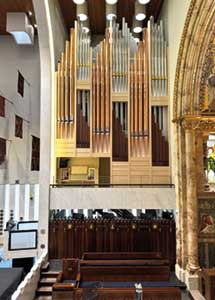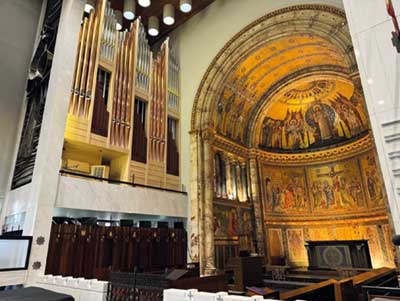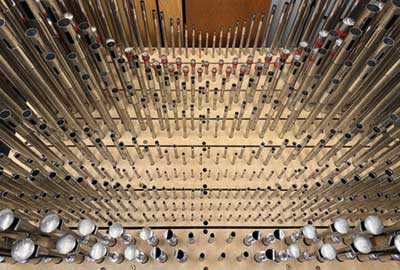|
A CATHEDRAL QUALITY PIPE ORGAN FOR THE GUARDS’ CHAPEL
by Major General R H Talbot Rice CBE
formerly Welsh Guards
Chair of the Guards Chapel Committee
|
In the last few months, the Guards’ Chapel has been much enhanced by the addition of a new pipe organ built by the country’s leading organ builder. This short article explains how this came about.
The Royal Military Chapel, which we know as the Guards’ Chapel, was built in 1838, remodelled in the 1870s, bombed in 1944, and largely rebuilt in 1963.1 The new Chapel incorporated just a simple electric organ, but in 1971 the first pipe organ was installed by Hill, Norman & Beard.2 It came to the Chapel second hand, much of the source material coming from the Organ Room at Glyndebourne, and included pipes originating from a large instrument built in 1919 for a private house in Wimbledon.3
 The old organ The old organ
|

The new organ viewed from the band loft
|
Impressive as its history was, the old organ did not age like a Stradivarius. Although adaptions were made in the 1980s and 1990s, the limitations of its design and its unreliability made it increasingly unable to meet the demands placed upon it. Many pipe organs have to work with a choir and a congregation, and for solo recitals, but few need to match a military band. A 2015 report by leading organ expert Dr William McVicker concluded that the organ was tonally ill-equipped to work alongside the choir and bands; was not of suitable quality to be used as a solo recital instrument; and suffered from serious mechanical and electrical failings.
After carefully considering options to repair or enhance the old organ, the Chapel Committee decided in 2018 that complete replacement with a new instrument was the best solution. With Dr McVicker’s assistance, three leading British organ builders were invited to bid; and following visits to each, the design by Harrison & Harrison of Durham was selected in February 2020.
In finalising the design, the Chapel Committee was advised by the architect Jonathan Louth, who helped to prepare the planning application and advised on how to ensure that the new organ best complemented the original architect’s design. With the new organ almost twice the weight of the old, we also took advice from the structural engineer Robert Bowles (a former Royal Engineer who has for many years advised cathedrals and churches). Although the original design drawings no longer existed, he was able to determine how the organ loft had been constructed; and devised a system of reinforcing beams to supplement what had been provided for the old organ. Planning consent was granted by Westminster City Council in March 2021 and the old organ was removed by Harrison & Harrison in August that year.4 We had hoped that it would go to a new home, but despite visits from other churches to assess it, the organ ended up being recycled: old pipes being melted down to make new. An electronic instrument was hired to provide accompaniment until the new organ was installed.
After signing the contract for the new organ in September 2021, there were various tasks which fell to the Chapel Committee to plan and action (with help from Jonathan Louth), including preparation of the organ loft floor and walls, moving electrical connections, installing new safety rails in both the organ and band lofts, and provision of scaffolding.5 We also replaced the unsatisfactory pegboard behind the aluminium sculptures that separate the organ and band lofts from the nave with a brighter and more transparent backing.6
Work by Harrison & Harrison to build the new organ began in earnest in early 2022. The task included constructing the case, soundboards, wind chests and reservoirs, shutters, console, and 2192 handmade pipes in sizes varying from 6 inches to 32 feet. Organ afficionados will be pleased to hear that the Guards’ Chapel organ has three manuals (i.e. three keyboards), but because we have both a Primary and Secondary Great Organ, the design effectively gives the organist the choice of four manual divisions and a pedal organ. Visually the copper, bright tin, and wooden pipes on the face of the instrument reflect the familiar colours of both the old sanctuary and the newer apse and nave. Internally, the organ has walkways, ladders and handrails which make tuning and servicing far easier.
The process of installing the organ began in September 2023. By November the casing and front pipes were fully installed. After fitting internal pipes in January 2024, the highly skilled process of tuning the organ (known as voicing) took place in February and March. The first full service at which the organ played was Easter Sunday, 31st March 2024.
 The new organ viewed from the nave The new organ viewed from the nave
|
Funded by non-public money and private donations, the project was completed within the budgeted cost. It would not have been possible without the support of a number of very generous friends of the Household Division: the Army Central Fund, and the Regimental Trustees of the Household Cavalry and Foot Guards regiments. His Majesty The King has been a great supporter, and when still Prince of Wales kindly agreed to be patron of the Organ Appeal. We still have a little way to go with fundraising to ensure that the project will not affect other planned activities, and I hope that readers will help by joining the ‘Sponsor a Pipe’ scheme which will shortly be publicised.
The project leaves a lasting legacy in more ways than one. The instrument itself will enhance services and recitals for the next century or more, delivering cathedral quality music in the Guards’ Chapel for generations to come. It also demonstrates the value of setting ambitious goals and doing things properly, in true Household Division style, rather than settling for the mediocre. This success has already sparked thoughts for further enhancements to the Chapel, including plans to make it more welcoming, better lit, and accessible.
There will be plenty of opportunities over the coming months to hear the new organ being put through its paces, all of which will be publicised by the Senior Chaplain and his team through the Household Division website. Readers should note in particular that there will be a special dedication service on 16th June 2024, which will also mark the 80th anniversary of the bombing of the Guards’ Chapel; and an evening organ recital on 5th September 2024 including the first performance of a specially commissioned work.

Some of the internal pipes
|
Notes:
1. The original building, of which only the chancel remains, was largely destroyed by a V1 flying bomb which killed 121 worshipers during a Sunday service on 18th June 1944. The War Memorial Cloister was built in 1956, and the remainder was rebuilt in 1963 to a design by the architect Bruce George.
2. During our work we uncovered the recesses in the east wall which housed the original speakers. One is visible above the chamade (the trumpet style pipes) in the band loft.
3. The house belonged to a Mr Boustead and is now the Cannizaro Hotel, part of the Hotel du Vin chain. Boustead had his organ console in the ground floor music room. The pipework and wind mechanism for the instrument were all in the cellar below and sounded into the room above through grilles in the floor. Dinner at his house must have been memorable.
4. In the past, decisions were taken by the Chapel Committee alone, but the Planning Act now requires planning consent to be sought for alterations to listed buildings, and the Chapel was listed Grade II* in 1970. The Ecclesiastical Exemptions Order (2010) allows consecrated church buildings to be overseen by a diocesan faculty. However, like all other military chapels the Guards’ Chapel is not consecrated, and therefore falls outside the authority of the local Church of England diocese. This reflects a long-standing desire for military chapels, which historically were transitory, to retain independence from local diocesan control.
5. The Defence Infrastructure Organisation organised the changes to electrical connections.
6. The sculptures ‘Passive Standard’ to the north and ‘Active Standard’ to the south were the work of Geoffrey Clarke ARCA, and were completed in 1963. When originally installed, they were open-backed, and light shone through them from behind. The new backing, which is brighter and more transparent, helps to recreate this effect.
|
|

 The old organ
The old organ
 The new organ viewed from the nave
The new organ viewed from the nave 